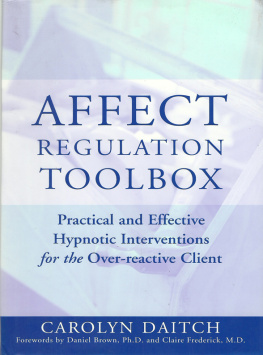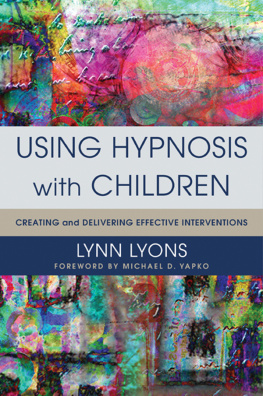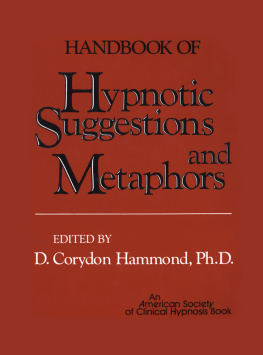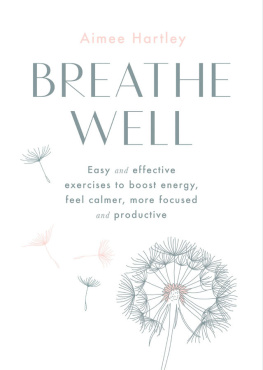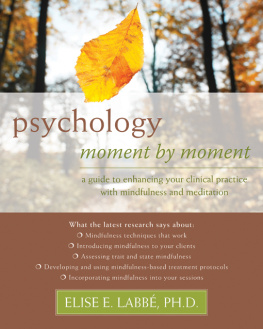Contents

Copyright 2007 by Carolyn Daitch
All rights reserved
First Edition
For information about permission to reproduce selections from this book, write to Permissions, W. W. Norton & Company, Inc., 500 Fifth Avenue, New York, NY 10110
Composition and design by Publication Services
Production Manger: Leeann Graham
Library of Congress Cataloging-in-Publication Data
Daitch, Carolyn.
Affect regulation toolbox : practical and effective hypnotic interventions for the over-reactive client / Carolyn Daitch.
p. cm. (A Norton professional book)
Includes bibliographical references and index.
ISBN-13: 978-0-393-70495-2
ISBN-10: 0-393-70495-5
ISBN: 978-0-393-70897-4 (e-book)
1. AnxietyTreatment. 2. HypnotismTherapeutic use. I. Title.
RC531.D35 2006
616.8522326dc22
2006049456
W. W. Norton & Company, Inc., 500 Fifth Avenue, New York, N.Y. 10110
www.wwnorton.com
W. W. Norton & Company Ltd., Castle House, 75/76 Wells St., London
WIT 3QT

Weve all experienced itthat exhilarating feeling when one of our therapeutic interventions has contributed to a breakthrough in a clients life. My colleague, Natalie Wick, remarked that when people are singing and dancing and growing in therapy, it is tremendously moving. At those times, I have no doubt about my purpose in our world (personal communication, November 29, 2005). Yet as a supervisor and consultant to therapists, I frequently witness the frustration and discouragement of dedicated clinicians who fail to meet the expectations of their clients or themselves, despite their best efforts.
Even gifted, highly experienced clinicians come up against this same dilemma. Geri, a clinical psychologist in private practice, requested a private supervision session, asking that it be scheduled sooner than her regular consultation appointment with me. She shared with me a case of a single mother who had adopted two special-needs children ages 11 and 14 who had originally been her foster children. The client was burdened with multiple challenges. She had to cope with her childrens special-needs, a limited income, and a low threshold for stress. The last time I saw her, Geri said, she looked at me with sullen eyes with barely a glimmer of hope. In the evenings, alone with her children, she would become overwhelmed with the chaos in her house, and frequently lose her temper. My client broke down crying as she admitted that she reacted to her younger sons refusal to eat dinner by slamming his dinner plate into the trash and threatening to send him back to a foster home. Yesterday she cancelled her next appointment. I doubt if shell reschedule, Geri confided. Geri went on to say how inadequate and helpless she felt as she encountered the horrific pain her client was bearing. Clearly, Geri lacked neither empathy nor motivation to help her client. She did lack, however, the resources and therapeutic skills necessary to help her client control her reactivity and prevent any ensuing damage to her children.
Ah, what therapist hasnt worn those uncomfortable shoes? said my writing peer and colleague Patricia Heck, addressing the agonizing dilemma that arises when our traditional methods of talk therapy fail. When I inquired as to the approach that Geri had taken, she informed me that she provided supportive, empathetic therapy, which validated the difficulty of raising special-needs children as a single parent. She also encouraged her client to examine the deficits in effective parenting that she received as a child. Geri needed to add practical, immediate interventions to her treatment that her client could master to increase her stress tolerance and diminish her inappropriate reactions to her children.
The Toolbox was developed with therapists such as Geri in mind, as well as the clinicians who are students of hypnosis. This book is not simply a collection of therapeutic interventions. It establishes a protocol for increasing the likelihood of ensuring transfer of therapeutic learning with the goal of interrupting affect dysregulation. It is divided into four components that I have called tiers, which can be conceptualized as follows: Tier 1, recognition of an over-reaction and initiation of a brief pause to interrupt it; Tier 2, standard hypnotic induction and deepening techniques; Tier 3, tools aimed at shifting unhealthy reactive styles; and Tier 4, tools to address therapeutic transfer of suggestions and practice. The effectiveness of the overall process is facilitated by the sequential implementation. Overall, the Toolbox can be adapted to treat a wide range of individuals and conditions.
Therapists are challenged every day by individuals who struggle with over-reacting in a variety of contexts. Janet was referred to me by her internist to treat her excessive sensitivity to sounds. She is a 47-year-old single woman who is employed as an attorney in a small law firm. During the initial consultation, Janet reported that she was unable to sleep at night because she found the traffic sounds from the main road adjacent to her home to be intolerable. However, when she asked several neighbors if they were also disturbed by the noise, they reported to her that it was barely discernable to them. At the onset of treatment, her reactivity to the auditory stimulation was causing her great distress; the insomnia resulting from the sensitivity to the street noise left her feeling exhausted, irritable, and unable to concentrate at work. Being highly sensitive to any one or a combination of the five senses is just one type of predisposition that might engender over-reactivity.
Physicians and psychotherapists alike also frequently encounter patients who are over-reactive to physical symptoms. Ryan, a 55-year-old electrician, is a scanner. He obsessively scans his body for somatic symptoms and then worries about whether they portend catastrophic illness. He frequently seeks out medical consultations that consistently reveal that there is no organic basis to his complaints. You may recognize this type of over-reactor as the classic hypochondriac.
Over-reactions are especially damaging for a relationship in which one or both of the individuals in the couple are overly reactive. Consider Meg and Dave, a young, bright, well-educated couple. Meg, a stay-at-home mother, complained that it was nearly impossible to get Daves attention and cooperation. For example, she said that no matter how often she asked him to call to let her know what time hed be home for dinner, Dave would seldom comply. When he finally would arrive, usually after the children were in bed, she would typically greet him with a litany of complaints about the children, his neglect, and his inconsideration. He would respond by withdrawing, turning his attention to his computer or the television. Not surprisingly, his isolating behavior triggered more frustration and led to more accusatory and demanding responses from Meg. This in turn elicited further withdrawal from Dave, a common dysfunctional response that impedes intimate connection.
The approach to couples therapy that I employed with Meg and Dave was based on the principles and approaches that I learned in my training as an Imago therapist, emphasizing active listening with validation and empathy. Meg and Dave were quick studies, and after a couple of months of diligent work, they were able to contain over-reactivity and escalation of conflict, thereby enabling them to execute their dialogue with precise mirroring and generous displays of validation and empathy in the therapeutic context. We soon discovered, however, that the transfer of skills fell apart when either Meg or Dave were under stress. Needless to say, they were disappointed in their results and critical of themselves and each other. They also expressed increasing pessimism about the time and expense devoted to therapy. Many clients like those just mentioned are able to find some degree of mastery of their thoughts, feelings, or communication skills while in the therapists office. It is when they go back to their own environments, however, where the triggers are present that they experience failure and are unable to implement these therapeutic lessons.

